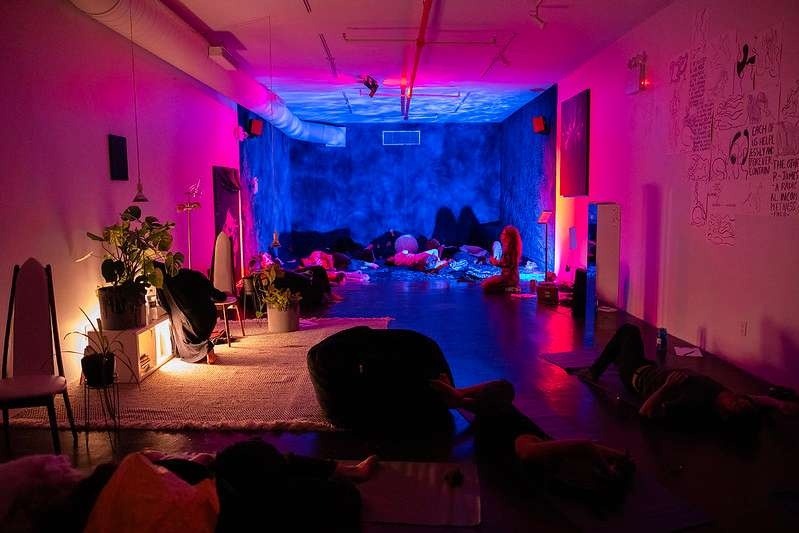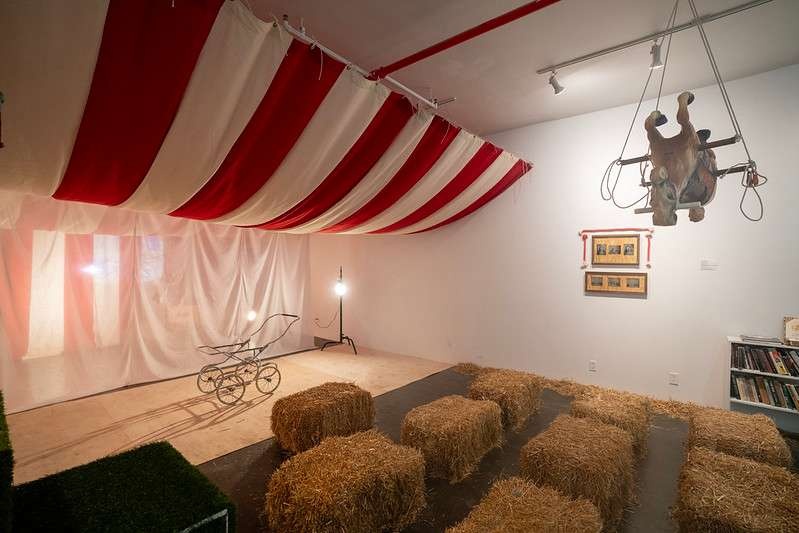The first time I met Demian was at a new York city queer art film fest, the one that sometimes turns into a sex party. I was probably trying to enjoy myself and not quite making it. It was either the night before or after the first time that I saw needle play: people on a makeshift stage were pierced with needles that connected by string to other needles threaded under the skin of the person next to them. Later or before when Demian asked me, smiling not even interrogating, what my clans were and I panicked. The phonemes that came garbling out were what I thought sounded like Kiyaa’áanii, the clan name I remember most often, after dozens of times of asking my mom to remind me. Instead of the forgotten name of the other clan, I rushed through an attempt to explain the very broken circle of my family. We said goodbye and later I realized what I’d actually said: a mispronounced version of nádleeh, the Diné Bizaad term for “two-spirit.” I skirt the sacrilegious reaching for objects, meanings from a world I never quite land on.
This is how I have carried the fundamental lack that the colonized is meant to feel. Shame becomes the box, and the poison emptiness that fills the box. I want to take that flush of ingested shame and spill it outward. Writing on the politically powerful feelings of resentment, rage, and anger in the colonized, Dene scholar Glen Coulthard speaks of the potential of these so-called negative feelings when turned against the colonizer rather than ourselves. His work draws heavily on Frantz Fanon’s idea of the transformative political power of violence against the colonizer. The native (the native, a figure not just of north America but in the multiple colonies of the globe) of anger is rooted in historical wrong but grows toward the future firmament. Coulthard with Fanon sees anger weaponized as “red-hot cannonballs and bloody knives” piercing and blowing through “the stagnancy and inertia that characterizes the colonial world.” These images evoke warfare with its strategy and action, but at the trembling core of these maneuvers are the more volatile and fragile forces. Love and Anger. And, yes, as Kate Bush sang, “The little piece of hope holding us together.”
During the major Indigenous Studies conference one year, Glen told me that Jennifer Denetdale (Navajo author and scholar who wrote a really good book about Juanita, wife of Manuelito, the famed Navajo war chief) once told him that it is foretold: when the Dene and the Diné meet, it heralds an apocalypse. The end of worlds, an event whose singularity is seen only by those who cannot or do not have to feel the cycles of the world very well. I had never heard this before. How do you tell someone you are Navajo only so far as you know that there a lot of things you don’t know? That you know the apocalypse but not its story.
What the call to collective fury makes space for is the transformation of shame. Where deconstructing the self is not self-destruction. Losing ourselves in each other but in such a way that it is not a taking away. It’s a multitude finding and riding the excess. Like David Wojnarowicz, “I wake up every morning in this killing machine called America and I’m carrying this rage like a blood filled egg.” Beside its forcefulness, there is a lingering fragility to this line— the vulnerability of the egg. The egg that threatens to break and spill. Collective fury is fragile. This fragile life is captured in an image in Leslie Marmon Silko’s Ceremony. Tayo, a man broken apart by colonization and his own participation in the colonizer’s imperialist war is taken to an old man, Ku’oosh, to see if the old man’s healing ways can help him. The old man talks and Tayo feels a lump of shame in his throat. Slowly it melts. He tries to listen. Ku’oosh tells him the world is fragile. Ku’oosh says fragile and means “continuing process.” Ku’oosh says fragile and means the strength of spider webs.
What we make in this space is like a spider web. The events held here, the events that call me to write, will end. They will be held together only as long as this diffuse collective maintains its shape. And then it will pass onto the forms of memory and archive. Let us heed the words of Albert Hosteen from the story arc spanning season one and two the X-Files when he says, speaking of UFO crashes and genocidal campaigns, “Nothing disappears without a trace.” The web is woven again. The creation story is repeated. A protest chant we all know rekindles quickly. You say the words one more time that your lover needs to cum.
And in those extended moments, we try to sustain an other world in this one, sometimes half successful or successful half the time…or less. I sometimes talk about my dream city. And in this city, there would be the structures, infrastructures, and desires to animate, support, maintain them for these moments to extend further. Maybe the dream city is where I am looking for my home, maybe the dream city is a place and time when home wouldn’t mean seem the bind it does for me today.
I went to Inwood Park to find mushrooms and instead I found a monument to the mythical purchase of Manahata. It is called the Shorakkopoch rock and it is thus ingrained: ACCORDING TO LEGEND, ON THIS SITE OF THE / PRINCIPAL MANHATTAN INDIAN VILLAGE, PETER MINUIT / IN 1626, PURCHASED MANHATTAN ISLAND FOR TRINKETS / AND BEADS THEN WORTH ABOUT 60 GUILDERS. / THIS BOULDER ALSO MARKS THE SPOT WHERE / A TULIP TREE (LIRIODENRON TULIPIFERA) GREW TO A HEIGHT / OF 165 FEET AND A GIRTH OF 20 FEET. IT WAS, UNTIL / ITS DEATH IN 1932 AT THE AGE OF 220 YEARS, THE LAST LIVING LINK WITH THE RECKGAWAWANG INDIANS / WHO LIVED HERE /
The rock of course tells lies but they are engraved and I wonder how many people have come here, read these words, and lets the willful production of ignorance work over them. I leave the park and walk to the Dominican chicken spot, El Rey de Pollo (a sovereign who does not ask you to bow), to think about these evil legends of landings and the actuality of being un-landed. Dominican diners become my microcosm of the new world. Columbus landed in what is now called the Dominican Republic in 1492, sometimes with his name all over this city I feel like I can still see his sails coming up the avenue. Two hundred years later after his voyage, the Dutch would be massacring Lenape people in Manahta. Hundreds of years later I would be by myself in a booth eating chicken and trying to will myself present.
Collective fury is a as a practice we are summoned here to consider and rehearse. Collective fury has that function of critique to undo and then turn to the work, to the building. Demian tells me Laura Ortman started playing violin because the songs that could fill her installations had not taken yet taken shape. She had to summon other scapes and those who saw her perform in this space can attest to how she fills and rends and builds up space with her sound. In coming together under this call of collective fury, we are asked in small ways to reorder the city and allowing us to speak together in different formations. My friend Anne Spice once said there are things we cannot say unless we say them together. The shared practice of cultivating and directing our anger works against individualized shame, works against the individualizing that shame performs. The fear of being caught, suddenly outcast and made aware of the disciplined boundaries of your body. Fury hails the collective, the collective hails down fury. This is patterned dis-order for those disinterested in reason and its wages. I want those savage feelings.
And yet how do I reconcile this pull toward savagery with the desire for less death? The desire for multitude with my reclusive isolation? Inhabiting savagery opens us to the open violence of the settler even as we turn our backs to them. And as a political strategy, we may be rejecting civil life but still needing the food assistance, the welfare check, the things that were never enough to begin with and always at risk of being taken away, little by little or all at once. Even as I want us all to refuse and refuse and turn away, there are material needs met under recognition. There are short term strategies that keep us alive. And there are longer dreams, the ones that feel like they last all night, the dreams that tell us there is another way to live.
Coda:
gather your rage
sisters
gather your sadness
wrap it in
your own sacred skin
we will waste
no more time
we have always been
at war
-Anne Spice, for Tina Fontaine murdered by Raymond Cormier
About the artist
Explore/Archive
See allDecember 2025
The INSTITUTE FOR TRANSHUMANIST CEPHALOPOD EVOLUTION and Learning from Octopuses
Barbara London
Barbara London reflect's of Miriam SImun's INSTITUTE FOR TRANSHUMANIST CEPHALOPOD EVOLUTION
October 2025
streamlined reflections, courtesy of noise canceling headphones
Gabrielle Rucker
Gabrielle Rucker reflects on the radical intimacy and auditory life at the heart of Deli Radio
July 2025
Tell My Jockey: CUNTRY’s Discourse From the Horse’s Mouth
Ericka Pérez
Assembly fellow Ericka Pérez reflects on clowning, resistance, and CUNTRY’s radical refusal to perform.





